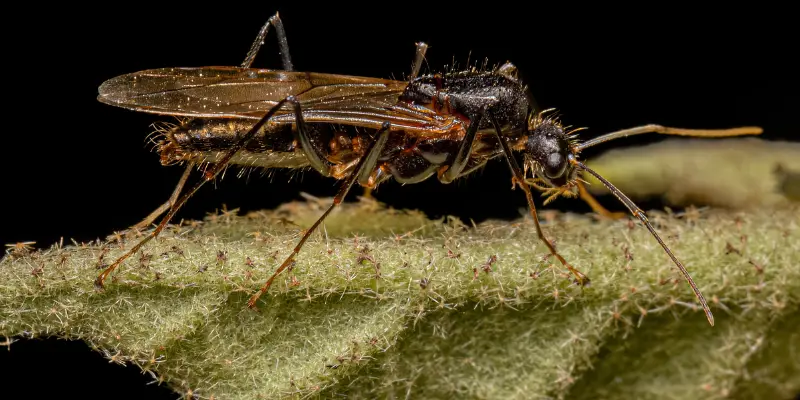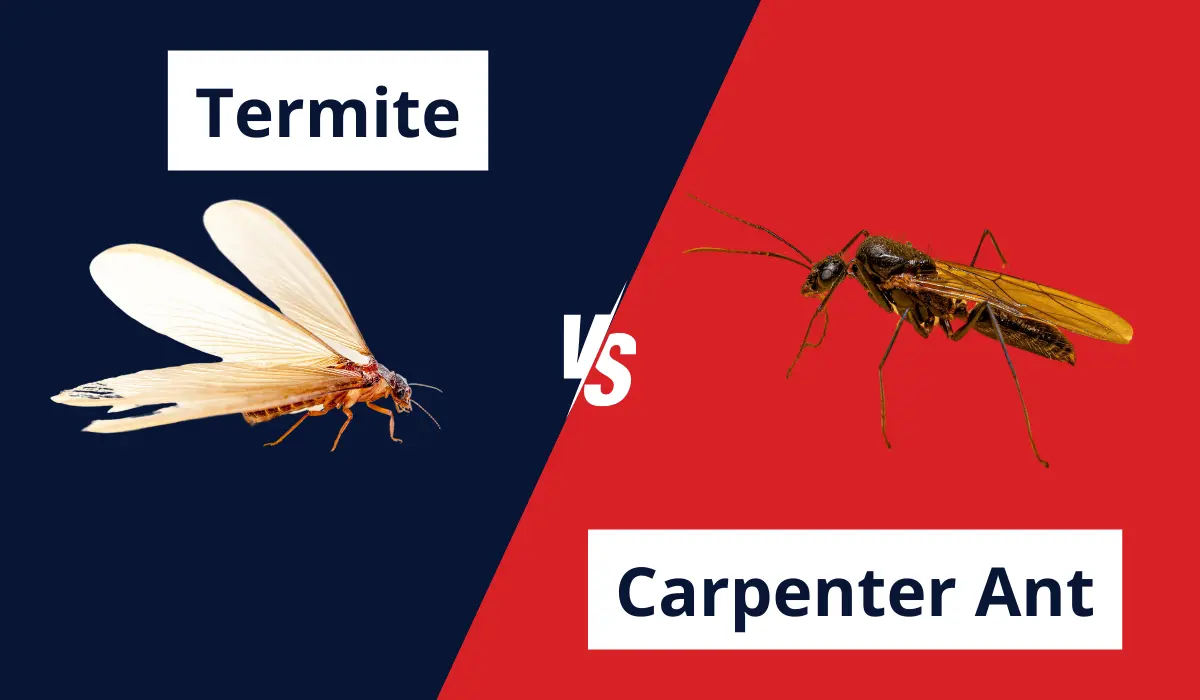
In Louisiana’s steamy climate, flying insects like winged ants and termites thrive, often causing mix-ups with their look-alikes.
Spotting the difference between these party crashers can help you figure out what course of action to take. So with that being said, let’s dive into figuring out who’s who in the bug world.
Key Takeaways
- Winged carpenter ants, known for having two sets of wings, the larger front pair, emerge in spring or early summer to mate and start new colonies.
- Recognizing termites is crucial because they cause significant property damage, with swarmers having equal-sized wings and a thick waist.
- To prevent costly repairs, early detection of ant and termite infestations involves looking for mud tubes, frass, discarded wings, and hollow sounds in wood.
- Effective prevention against ants and termites includes maintaining low humidity and sealing entry points.
- Professional pest control may offer thorough inspections and customized ant and termite treatment plans.
WHAT DO CARPENTER ANTS LOOK LIKE?
As Louisiana homeowners, you may often encounter carpenter ants, known to establish new colonies within wood structures.
These ants differ from others in size, shape, and behavior, making it essential to recognize them for effective management.
Carpenter ants stand out due to their larger size in dark brown to black coloration.
In contrast to other ants, they have a broad waist and straight antennae, which are noticeable upon close inspection.
Here’s a closer look to differentiate them from other worker ant species:
| Feature | Carpenter Ants | Other Louisiana Ants |
| Size | Larger (up to ⅝ inch) | Smaller (varies) |
| Color | Dark brown to black | Varies |
| Antennae | Straight | Often elbowed |
| Waist | Broad | Usually pinched |
| Wings (If present) | Longer front wings, unequal in size | Equal-sized wings |
| Body Shape | Oval, robust | Often slimmer, less robust |
Winged carpenter ants are a specific phase of the carpenter ant life cycle known as “ant swarmers” or “reproductives.”
These ants emerge from established colonies, typically in the spring or early summer, with the sole purpose of mating and starting new colonies.
Here’s what you should know about winged carpenter ants:
- Appearance: They possess two sets of wings, with the front pair larger than the hind wings.
- Size: They can range from about 1/4 to 3/4 inches in length, making them some of the largest ants you might encounter.
WHAT DO TERMITES LOOK LIKE?
In Louisiana, distinguishing between winged ants and termites is crucial to managing potential infestations effectively.
Termite swarmers, or alates, are often mistaken for carpenter ants. However, several critical physical characteristics distinguish them from each other.
Here’s a quick guide to help you with termite identification:
| Characteristic | Termites |
| Antennae | Straight |
| Waist | Thick |
| Wing Length | Equal |
| Wing Attachment | Two pairs, both sets of equal length, quickly shed |
| Location | Common in Louisiana, particularly in Baton Rouge and New Orleans |
The most common termite species encountered in Louisiana are:
- The Formosan subterranean termites
- The drywood termites
Both species have swarmers in a termite colony that can appear in large numbers during a termite swarm.
CARPENTER ANTS VS. TERMITES

Identifying winged ants and flying termites is crucial, as they differ in physical characteristics and wing features.
Physical Characteristics
Ants and termites significantly differ in their appearance. Here’s what sets them apart:
| Feature | Carpenter Ants | Winged Termites |
| Body Shape | Pinched waist | Broad waist with no pinch |
| Antenna Shape | Elbowed antennas | Straight, beaded antennas |
| Size | Varies, generally larger | Typically smaller |
Wing Features
Despite having two pairs of wings, termite and ant wings aren’t the same, quickly giving away their identities.
Here’s a detailed comparison between the two flying insects:
| Wing Attribute | Carpenter Ants | Termites |
| Wing Size | The front wings are larger than the hind wings | All four wings are equal in size |
| Wing Shape | Narrower and longer front wings | Uniform in shape and size |
| Durability | Wings shed quickly and may be found around | Wings do not shed as easily |
SIGNS OF A TERMITE INFESTATION
Spotting the signs of infestation can save your Louisiana homes from costly repairs. These flying pests can be devastating given the state’s warm, moist environment.
Identifying Flying Insect Infestation
As homeowners in Louisiana, early detection of infestations is vital to prevent widespread damage.
Here is a checklist to help spot the early signs of termite and winged ant activity:
- Mud Tubes: Look for pencil-sized mud tubes near the home’s foundation; termites use these to travel.
- Frass: Termites leave behind droppings, called frass, which resemble small mounds of pepper or sawdust.
- Wings: Both pests shed their wings; finding discarded wings can indicate an infestation.
- Hollow Sound: Tap on wood structures; a hollow sound can mean termites have compromised the wood.
- Visible Insects: Spotting the insects themselves is a clear sign. Termites are often mistaken for winged ants, but termite wings are equal in size and have straight waists, unlike ants’ pinched waists.
- Moisture Damage: Excess moisture can attract these pests, so look for water damage or wood decay signs.
EFFECTIVE PREVENTION AND CONTROL METHODS
Combating winged ants and termites in Louisiana starts with proactive measures for prevention and professional options for when infestations occur.
DIY Prevention Tips
To safeguard your homes against these pests, you can take these effective strategies:
- Maintain low humidity.
- Seal all entry points.
- Store firewood properly.
- Routine home inspections.
- Trim vegetation and lawn.
- Store food in airtight containers.
Professional Pest Control
When prevention isn’t enough, calling in the exterminators is best. Here are some benefits of professional pest control:
- Thorough Ant and Termite Inspections
- Customized Ant and Termite Treatment Plans
- Advanced Treatment Methods
- Follow-Up Services
SHOULD YOU GET IN TOUCH WITH THE EXPERTS?
When distinguishing between winged ants and termites in Louisiana, you might wonder if it’s time to ring up a specialist.
If the little wings or mysterious damage raises an eyebrow, don’t do it alone. Enlist pest control professionals to demystify the situation!
Whether you’re in New Orleans or Baton Rouge, seeking expert help should be easy. For immediate intervention for a severe infestation, let Lajaunie’s ant and termite control specialists tailor a solution that’s right for your home.
For more information about the areas we service, visit our location page.